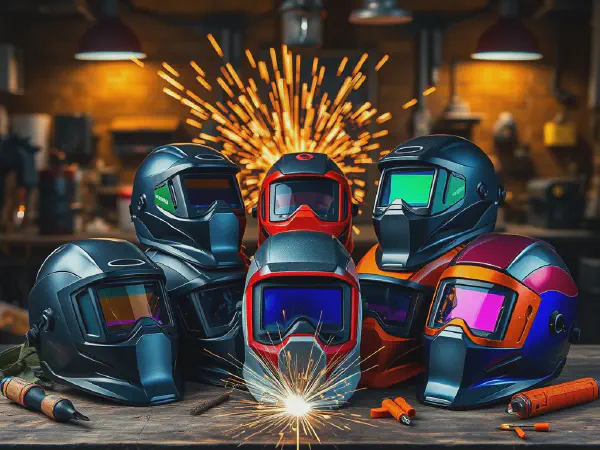Best Welding Helmets for Beginners: A Comprehensive Guide

Welding Helmets: Essential Gear for Safety and Precision
Welding helmets are critical protective gear for anyone involved in welding, whether professionally or as a hobbyist. These helmets shield the welder's face and neck from harmful radiation, intense heat, and flying debris. With a variety of styles and features available, selecting the right welding helmet can be pivotal for both safety and comfort during welding tasks.
The primary function of welding helmets is to protect the welder's eyes and face from the bright light emitted during the welding process, which can cause serious eye injuries and long-term damage. Welding helmets use darkened lenses that adjust to the brightness of the light, ensuring that the welder can see the work area while maintaining protection against harmful rays. Understanding the different types and features of welding helmets can help you make an informed decision when purchasing this essential equipment.
Welding helmets are designed with a variety of features to enhance safety and functionality. Key aspects include lens types, weight, comfort, and build material durability. These factors play a significant role in the user experience and overall effectiveness of the helmet. In addition, modern welding helmets often come with advanced technologies such as auto-darkening lenses that provide convenience and ease of use for welders of all skill levels.
Welders should also consider additional features such as adjustable sensitivity settings, which allow for customization based on the type of welding being performed. The comfort of a helmet is significantly influenced by its weight and fit, making it crucial to find a model that suits the welder's needs. Moreover, durability of materials used in the helmet’s construction ensures a long lifespan, which is essential for those frequently engaged in welding activities.
In summary, welding helmets are an indispensable tool for welders, ensuring safety and efficiency while performing welding tasks. With many options available on the market, it is vital for users to select helmets that meet their specific needs and adhere to safety standards. This article will delve into crucial features to look for in beginner welding helmets, safety standards, reputable brands, maintenance tips, and the cost-quality balance in selecting the right welding helmet.
Features to Look for in Beginner Welding Helmets
One of the key features to seek in beginner welding helmets is auto-darkening lenses. These lenses automatically adjust their tint based on the intensity of the light from the welding arc. This technology allows the welder to maintain visibility of their work area before and after striking an arc, providing greater convenience and reducing the risk of eye strain caused by constantly flipping the helmet up and down.
Another important feature is adjustable sensitivity settings. Many beginner welding helmets come equipped with this feature, allowing the user to customize the lens sensitivity according to the welding type and environment. This ensures that the helmet can react appropriately to changes in light intensity, enhancing safety and comfort during different welding processes.
Comfort and weight considerations are also essential when selecting a welding helmet. A lightweight helmet will decrease neck fatigue during prolonged use, while a comfortable fit will ensure that the helmet stays securely in place. Look for options that offer padding and adjustable features to achieve the best fit for your specific needs.
Durability of materials is a crucial factor in the selection of a welding helmet. Helmets constructed from high-quality materials are more likely to withstand the rigors of welding work, including exposure to heat, sparks, and potential drops. Always check for helmets made from high-performance plastics or fiberglass to ensure longevity and reliability.
Finally, it's important to consider the UV and IR protection standards of the welding helmet. A good helmet should meet specific regulations, providing adequate protection against harmful ultraviolet (UV) and infrared (IR) rays, which can cause serious skin and eye damage. Look for helmets that indicate compliance with these standards to ensure maximum safety.
Safety Standards for Welding Helmets
Understanding ANSI and ISO standards is crucial when purchasing welding helmets. The American National Standards Institute (ANSI) and the International Organization for Standardization (ISO) set guidelines for safety equipment, including welding helmets. These standards assess the helmet's durability, protective features, and performance in various conditions, helping users make informed buying decisions.
Compliance with these safety standards is of the utmost importance to protect against potential workplace hazards. A helmet that meets ANSI and ISO guidelines ensures that welders are shielded from the risks associated with arcs, sparks, and harmful radiant energy, making it a vital consideration when selecting protective gear.
Impact resistance ratings are another safety feature to look for in welding helmets. Helmets undergo specific testing to evaluate their ability to withstand impacts from falling objects or accidental bumps. Helmets with a higher impact resistance rating will provide better protection in the field, making them a valuable choice for welders working in dynamic environments.
Light transmission levels are particularly significant in auto-darkening welding helmets. The best helmets should have a low-number light transmission rating when darkened, ensuring optimal visibility during welding. Additionally, these helmets should maintain clear viewing in non-welding states, allowing for versatility and ease of use.
Finally, the certification processes of welding helmets assure users that these products have been rigorously tested for quality and safety. Reliable brands will provide certification details, giving peace of mind that the helmet will perform as expected in real-world applications.
Top Brands for Beginner Welding Helmets
Lincoln Electric is one of the most recognized names in the welding industry, offering a range of beginner welding helmets known for their quality and reliability. Their products often feature user-friendly tech such as auto-darkening and lightweight designs, which cater to the needs of novice welders.
Hobart is another reputable brand that manufactures high-quality welder helmets suitable for beginners. Their products are known for affordability and efficiency, making them a popular choice for those starting their welding journey. The Hobart helmets typically have excellent visibility and comfort, making them ideal for extended use.
Miller welding equipment holds a considerable reputation for producing innovative and high-performing welding helmets. With advanced features and ergonomic designs, Miller helmets are ideal for both beginners and experienced welders. They offer products that provide comprehensive protection while maintaining a user-friendly experience.
ESAB beginner helmets are designed to ensure easy use and reliable protection for new welders. This brand is well-regarded in the welding community for its affordable yet effective helmets, which provide essential features such as adjustable sensitivity and comfortable padding.
Lastly, 3M helmet products are recognized for their innovative designs and comfort features. With a focus on user safety and performance, 3M welding helmets often feature advanced optics and responsive auto-darkening technology, catering to beginners and experienced welders alike.
Maintaining Your Welding Helmet
Cleaning and care tips are essential for extending the life of a welding helmet. After each use, it is advisable to wipe the lens with a soft, clean cloth and lens cleaner to remove any debris, spatter, or dust. Regular maintenance helps prevent scratches and distortion on the lens, ensuring optimal visibility during usage.
Replacing lenses and filters should be performed as needed, especially if they become scratched or damaged. Helmets with replaceable lenses should have this aspect considered when purchasing, as it enhances the overall durability and usability of the helmet. Always ensure that replacements meet the manufacturer’s specifications.
Storage practices are also crucial in maintaining your helmet. It is best to store helmets in a protective case or shield away from direct sunlight and extreme temperatures. Proper storage can help avoid deterioration of materials and functionality, ensuring that the helmet remains in good working condition for future use.
Troubleshooting common issues may become necessary when the helmet does not function as expected. Common problems might include issues with the auto-darkening feature or obstructed viewing. If problems arise, consulting the user manual or contacting the manufacturer for support can help resolve any helmet-related issues.
Lastly, upgrades and enhancements are a consideration for welders looking to improve their safety gear. Users might look into supplemental accessories such as external protective shields or upgraded lenses that can enhance visibility and protection during their welding projects.
Cost vs. Quality in Beginner Welding Helmets
Budget-friendly options for welding helmets are abundant, especially for beginners. Many reputable brands offer affordable products that ensure basic safety and functionality without breaking the bank. It is crucial to balance price and essential features to find a helmet that matches your welding needs.
Mid-range selections may offer additional features such as auto-darkening technology and enhanced comfort without the hefty price tag of high-end products. These options can strike a balance between affordability and reliable quality, making them suitable for dedicated beginners.
High-end features worth the splurge often include advanced auto-darkening lenses with a wider range of sensitivity adjustments, superior impact resistance ratings, and enhanced comfort features. While these helmets have a higher upfront cost, the long-term benefits can justify the investment, particularly for those who frequently engage in welding tasks.
Considering the total cost of ownership is essential when selecting a welding helmet. This entails looking beyond the initial purchase price to evaluate the potential longevity, maintenance costs, and compatibility with replacement parts. A more durable helmet may require a larger investment upfront but relieve the buyer of frequent replacement costs.
Finally, a value for money analysis involves assessing both the features offered and the perceived benefits from using the helmet. With a wide range of options available, welders need to clarify their preferences and budget to find the best helmet that delivers safety, comfort, and quality for their welding projects.
